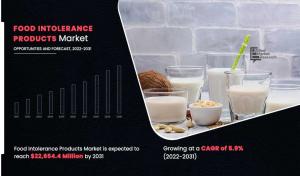Food Intolerance Products Market Size to Reach $22,654.4 Million by 2031: Nestle, General Mills, Abbott Laboratories
Global food intolerance products market was valued at $12,145.6 million in 2020, and is projected to reach $22,654.4 million by 2031, registering a CAGR of 5.9%
WILMINGTON, DE, UNITED STATES, January 3, 2025 /EINPresswire.com/ -- One of the primary reasons driving market expansion is the rising prevalence of celiac disease and lactose intolerance among the general population. Furthermore, increased health consciousness among the general public, as well as widespread adoption of vegan, gluten-free, and lactose-free food products, is boosting market growth.Request Sample PDF Of This Report: https://www.alliedmarketresearch.com/request-sample/1384
The growth in popularity of vegan diets, increased occurrences of lactose intolerance and celiac diseases have propelled and continue to drive the market for food intolerance products Industry.
The food intolerance products market has prospered as a result of medical developments that have studied and supplied a firm understanding of various immune system responses, allowing customers to make informed selections when purchasing food items. Furthermore, increased consumer preference for labelling and ingredient claims such as 'lactose-free' and 'gluten-free' has propelled the market for these food products.
Lactose-free food items have gained a significant proportion of the global market as the prevalence of lactose intolerance has increased. Diabetic foods are projected to create extremely profitable opportunities for companies in this market, owing to a considerable shift in dietary trends toward healthier and lower-sugar alternatives, as well as an increase in the number of diabetic patients worldwide. Owing to huge increase in demand for lactose-free products, players in the food allergy and intolerance products industry have shifted their focus to the creation of dairy-free products. Companies attempt to improve the taste, quality, and texture of their gluten-free products in order to distinguish them from competing alternatives.
Buy Now: https://www.alliedmarketresearch.com/food-intolerance-products-market/purchase-options
Gluten-free meals have become more popular around the world, owing to an increase in gluten allergies and celiac disease, a sickness that causes inflammation in the small intestines and high gluten sensitivity. According to the clinical practice journal of the American Gastroenterological Association, the global prevalence of celiac disease is 1.4 percent, with celiac prevalence values of 0.4 percent in South America, 0.5 percent in Africa & North America, 0.6 percent in Asia, and 0.8 percent in Europe & Oceania. Significant and remarkable advancements in ingredient formulations are expected to provide gluten-free labelling claims a boost. Furthermore, other health claims associated with gluten-free products, such as cholesterol management and digestion control, have piqued the curiosity of consumers, resulting in increased sales.
The COVID-19 outbreak had a twofold impact on these populations. This includes offline food chains such as restaurants and cafes that have been completely closed down in some areas, where as internet meal deliveries are available. Furthermore, the packaged food and beverage industries are seeing an increase in demand for shelf-stable goods & beverages, particularly milk products, as customers rush to stock their pantries. COVID-19 has had an impact on the food and beverage industries in nearly every region, including North America, Europe, Asia-Pacific, and the rest of the World. Asia-Pacific and Europe are the most affected regions globally.
The food intolerance products market is segmented on the basis of type, distribution channel, and geography. On the basis of type, the market is segmented into diabetic food, gluten-free food, lactose-free food, and other special milk formula. On the basis of distribution channel, the market is segmented into hypermarkets/supermarkets, convenience stores, online channels, and others. Geographically, the market is analyzed across North America, Europe, Asia-Pacific, and LAMEA.
Request For Customization: https://www.alliedmarketresearch.com/request-for-customization/1384
On the basis of product type, the market is divided into diabetic food, gluten-free food, lactose-free food, and other special milk formula. Lactose abstinence allows the gut to recover and eliminate nutritional deficits as well as other associated symptoms. Strict lactose-free diet adherence lowers the likelihood of developing many of the major long-term consequences associated with untreated lactose intolerance.
On the basis of sales channels, market is divided into hypermarkets/supermarkets, convenience stores, online channels, and others. Customers can easily obtain the goods in hypermarkets/supermarkets. Customer shopkeeper loyalty is very crucial in hypermarket/supermarket distribution, and getting genuine items is always a priority. This market is expected to grow rapidly in developing countries as consumers' purchasing power rises. Furthermore, the large number of customers in developing countries is projected to have a substantial impact on segment growth.
The key players in the market are Nestle S.A., General Mills, Inc., Abbott Laboratories, Kraft Heinz Company, Dr. Schär AG / SPA, Mead Johnson Nutrition Company, Danone S.A., Fifty 50 Foods Corporation, Boulder Brands, Inc., and Kellogg Company.
Key Findings Of The Study
On the basis of product type,lactose-free food is projected to witness the highest CAGR of 7.2%, in revenue terms, during the forecast period.
On the basis of distribution channel, the online segment is expected to grow at a significant CAGR during the forecast period.
On the basis of region, Asia-Pacific is anticipated to witness highest growthrate, registering a CAGR of 7.1% from 2022 to 2031
David Correa
Allied Market Research
+1 800-792-5285
email us here
Visit us on social media:
Facebook
X
1 https://www.alliedmarketresearch.com/food-intolerance-products-market

